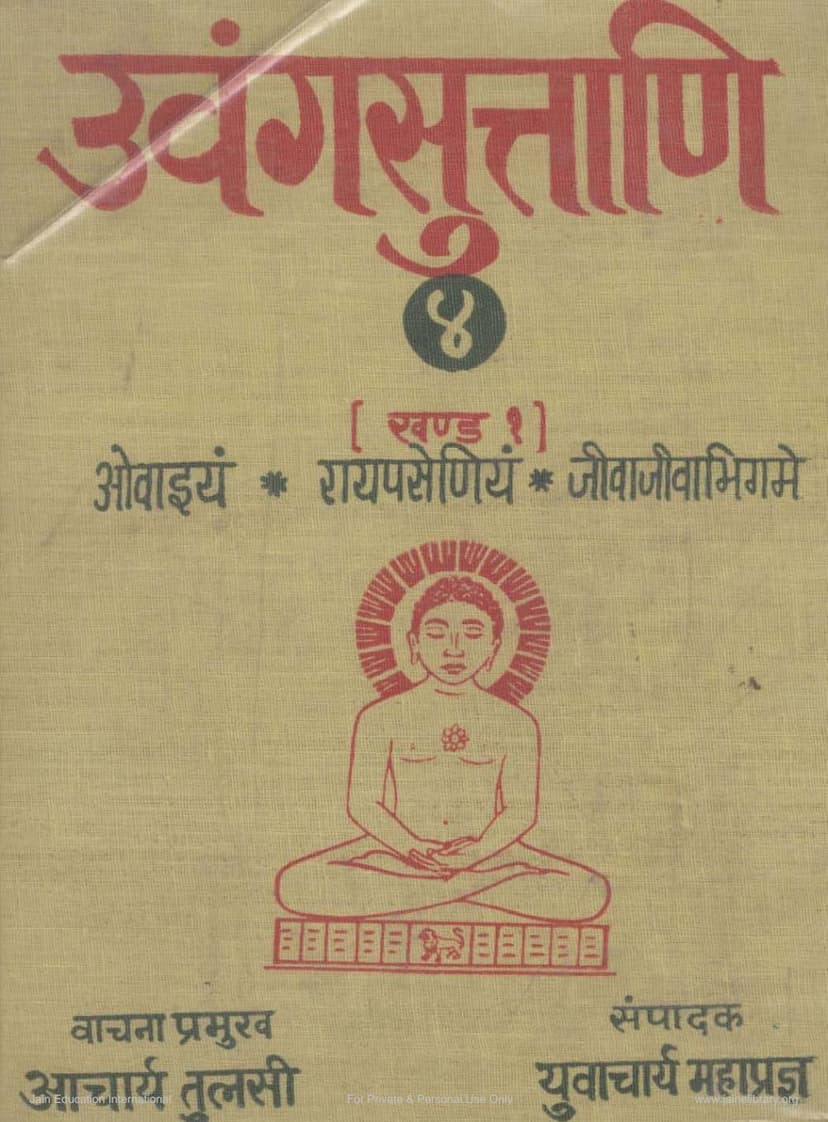Agam 12 Upang 01 Aupapatik Sutra Ovaiyam Terapanth
Added to library: September 1, 2025

Summary
This Jain text, Agam 12 Upang 01 Aupapatik Sutra Ovaiyam Terapanth, is part of the UVANGA SUTTANI (Upanga Sutras) series, Volume IV, Part 1. It was published by Jain Vishva Bharati, Ladnun, Rajasthan, in Vikram Samvat 2044 (1987 A.D.) in commemoration of Acharya Tulsi's Amrit Mahotsava Year. The publication was made possible by the munificence of Shri Ramlal Hansraj Golchha of Viratnagar, Nepal, and the financial co-operation of Mitra Parishad, Calcutta, for the Jain Vishva Bharati Press.
The volume contains the critically edited original text of three Upanga Agamas:
- Oväiyam (Aupapātika Sutra)
- Rāyapaseṇiyam (Rājapraśnīya Sutra)
- Jīvājīvābhigame (Jivājīvābhigama Sutra)
Key highlights from the editorial and introductory sections:
-
Comprehensive Agam Publication Plan: The publisher, Jain Vishva Bharati, outlines a multi-pronged approach to publishing Jain Agamas, including:
- Agam-Mukt Granthamala: Presenting original texts with variant readings and indices.
- Agam Anusandhan Granthamala: Presenting original texts with Sanskrit translation, Hindi translation, appendices, and critical notes.
- Agam Anushilan Granthamala: Presenting critical studies of Agamas.
- Agam Katha Granthamala: Compiling and translating stories related to Agamas.
- Vargikṛt-Agam Granthamala: Presenting classified summaries of Agamas.
- Agamon ke Hindi Anuvad: Editions with only Hindi translations.
-
Dedication and Acknowledgment: The text is dedicated to learned monks and scholars who contributed to the task of editing and publishing these significant Agamas. The publication is particularly dedicated to the memory of the monks "Kalugani" and "Jayasindhu" for their immense contribution to the study and editing of Agamas. Acharya Tulsi expresses deep satisfaction and gratitude to the editorial team, including Yuvaacharya Mahapragna (Editor), Muni Sudarshan, Muni Madhukar, and Muni Hiralal for their diligent work. Special mention is made of the financial support from various trusts and individuals.
-
Introduction to the Agamas:
- Oväiyam (Aupapātika Sutra):
- Nomenclature: Derived from "Upāta" (rebirth) and "Aupapātika" (related to instantaneous rebirth). The text serves as a repository of descriptions, hence frequently referenced in other Agamas as "Jahā Ovāie" (as in Aupapatika).
- Subject Matter: Primarily discusses rebirth, linking specific actions to future rebirths. It also includes extensive descriptions (varnakas) of cities, temples, parks, and royal courts, making it a rich source for understanding ancient Indian society and culture.
- Commentaries: The primary commentary is by Abhayadeva Suri, which is noted for its detailed handling of numerous variant readings. The "Stabaka" is mentioned as a secondary commentary.
- Rāyapaseṇiyam (Rājapraśnīya Sutra):
- Nomenclature: Named after King Pradeśi, who asked questions to Kesi Swami, and the Agamas containing the replies. The text is also referred to as "Rājapraśnīya" and "Rāyapasenaiya."
- Subject Matter: Describes the dialogue between King Pradeśi and Kesi Swami concerning philosophical and spiritual questions.
- Commentaries: The main commentary is by Acharya Malayagiri, noted for its extensive discussion of textual variations and its proper treatment of the subject.
- Jīvājīvābhigame:
- Nomenclature: The name signifies the exposition of Jiva (soul/sentient) and Ajiva (non-soul/non-sentient) as fundamental tattvas (principles).
- Subject Matter: It contains a numerical classification of sentient beings across nine chapters (Pratipadās). It also covers various aspects of Indian society, life, and architectural details like "Padmavaravedikā" and "Vijayadvāra." The text compiles differing opinions (ādeśas) of the Sthaviras.
- Authorship: Attributed to the Sthaviras.
- Commentaries: Available commentaries include those by Acharya Haribhadra (concise) and Acharya Malayagiri (elaborate), who frequently referenced the original commentary and Curni of Jivājīvābhigama.
- Oväiyam (Aupapātika Sutra):
-
Critical Editing and Variant Readings: The publication emphasizes the critical editing of the original texts based on manuscripts and commentaries. The editors acknowledge the abundance of variant readings in the Agamas, especially in Oväiyam, and the challenge of establishing a definitive text. They detail the extensive effort to compile and analyze these variations.
-
Manuscript Descriptions: The publication includes detailed descriptions of the various manuscripts used for the critical edition, noting their provenance, dimensions, number of leaves and pages, script style, and colophons. This highlights the scholarly rigor in establishing the text.
-
Variant Words and Forms: A section is dedicated to listing and distinguishing variant words and their grammatical forms, important for linguistic study.
-
Key Contributors: The work is attributed to Acharya Tulsi as the chief authority and Yuvaacharya Mahapragna as the chief editor. Numerous monks and sadhvis provided assistance in text revision, index preparation, and proofreading. The late Shri Madan Chandji Gothi is remembered for his invaluable contribution to Agama editing.
This volume represents a significant scholarly endeavor to preserve and present these foundational Jain scriptures with meticulous textual analysis and historical context.